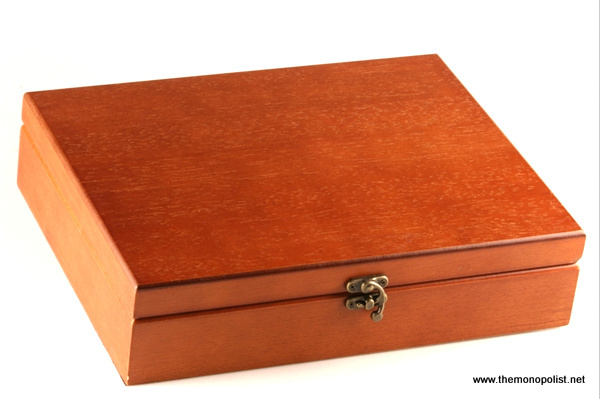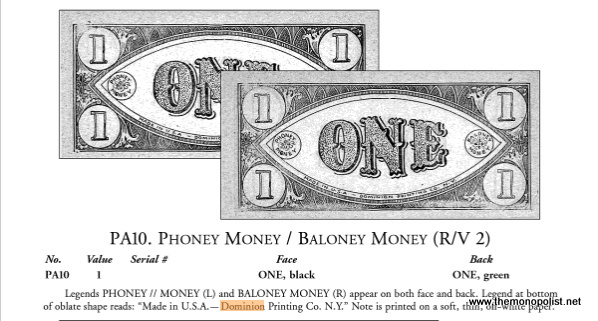
The short-lived 1935 Parker Brothers game Fortune is a rare and historically important early Monopoly variant, as it was briefly an essential piece in a chess game over control of property trading games, which were quickly becoming a national craze.
Why did Parker introduce a new Monopoly clone, just a few months after they took over Monopoly from Charles Darrow? Fortune was introduced after the Monopoly patent was filed on August 31, 1935. The earliest version of Fortune says, “Patent Pending.”
Shortly after filing this patent (eventually issued as #2026082 on December 31, 1935), Parker was informed by the US Patent Office that this would be considered as an improvement of the second Landlord’s Game patent #1509312, issued to Elizabeth Magie Phillips in 1924. So, to “monopolize” Monopoly, they would need to obtain the rights to her patent.
Negotiations were undertaken with Mrs. Phillips, who had also been contacted by both Milton Bradley (makers of Easy Money) and Knapp Electric (Finance). She eventually sold her patent to Parker Brothers in November 1935, after meeting with George S. Parker, the “King of Games.”
Mrs. Phillips could certainly have demanded a royalty on each Monopoly game sold– a royalty that Parker was already paying to Charles Darrow, who had falsely claimed to be the “inventor.” She did not do so, as this would have violated her Georgist beliefs. She filed her patents in order to receive proper credit for her inventions, not money.
For what is a patent, if not a legalized monopoly? And Henry George was opposed to monopolies.
The sole purpose of Fortune, then, was to put a property trading game on the market that owed nothing to Charles Darrow and his supposed improvements to Monopoly. If Parker had to suddenly cut Darrow out of the picture, they would have a game they could sell to take its place. Comparing the two games, we can see just what it is that Parker thought was Darrow’s intellectual property.
First there is the name. While he did not create the game Monopoly, Darrow was certainly the first to try marketing it on a wide scale. As an alternative, Fortune is an excellent, strong choice.
Second, there was Darrow’s board design and the iconic cartoonlike illustrations he created. Parker Brothers appreciated their importance to Monopoly’s success, and therefore, Fortune had different cartoons of its own.
Third, were the Hotels. Fortune does not have any, using 40 Houses instead. But Hotels were not a Darrow innovation– they were introduced to Monopoly some years earlier by the Thuns in their version. (See our earlier post Thun Monopoly, May 10, 2017.)
As things played out, Parker Brothers bought the second Landlord’s patent, which set other things into motion. Milton Bradley had to negotiate changes to their lookalike Easy Money game so Parker Brothers would grant them a license. (In 1937, perhaps in response to this, Milton Bradley issued the game Carnival, which was based on the earlier, expired first Landlord’s Game patent.)
Knapp Electric sold Finance to Parker Brothers in January 1936. During 1936, Parker Brothers offered a revised version of Finance through a dummy, the Finance Game Corporation, based out of their New York office. While it is not clear why they did it this way, they may have wanted to distance themselves from the Knapp transaction for various reasons.
Knapp’s Finance had been on the market since 1932, more or less at the same time, or even before, Charles Darrow had claimed he invented Monopoly. A connection with Parker Brothers would undermine that story, and therefore, undermine the Monopoly patent.
Fortune has both Chance and Community Chest cards as these were also present in the 1932 version of Finance. Darrow could not credibly claim to have added Community Chest cards to the game. (Chance cards were introduced as early as the 1906 version of The Landlord’s Game.)
In addition, in Spring 1936, Parker placed trade ads, advertising how they were now licensing their two patents to Easy Money (through Milton Bradley) and Finance (through the Finance Game Company). Fortune was discontinued.
Parker eventually sued Rudy Copeland over his Inflation game, charging that it was infringing, but this soon backfired on them. Copeland found many early Monopoly players who would testify on his behalf, and Parker was forced to settle out of court, paying for Copeland’s legal fees and granting him a license to the two patents.
Charles Darrow was forced to accept a lower royalty rate, but in turn, licensed Parker Brothers for international sales, which was a “win-win” in the long run for both parties.
Parker’s main concern in 1935 was establishing as much right to Monopoly as possible, to keep their competitors from flooding the market with knock-offs, which had happened a decade earlier during the Mah Jongg craze.
1936, the peak Monopoly year, was the focus of their activities. They fully expected the Monopoly craze to fade after that, as had happened with so many other games– but we know that history took a different turn. It did fade, but not to the point where Parker ever stopped producing and selling Monopoly. Eventually, sales picked up again.
Soon, Parker began selling Finance under their own name, and added the name Fortune, resulting in Finance and Fortune. Perhaps eventually realizing they were wasting a good name, they used Fortune again in the 1950s for an unrelated marbles game.
I assembled this now-complete Fortune set from two different auctions, with an overall value of $1450. That might seem like a lot of money (it is), but as they say, try to find another one.
-David Sadowski

Interestingly, Parker put the Fortune board logo on a diagonal, many years before this was done with Monopoly.

This 1935 Fortune board and utensils box have been reunited at last, making this a complete set.

Darrow Type 2 play money was used. The total amount was $9,000– the same as the Darrow and early Parker Brothers sets.

Fortune’s rules were nearly identical to Monopoly but were somewhat rewritten by the Parker staff, at around the same time that revisions were being made to help clarify the Monopoly rules.

Parker Brothers saved money on colored ink, and simplified the printing process for these Title Cards, which use symbols instead of colors to denote the various property groups. Parker also began using symbols on their Monopoly rules sheets in 1936, to identify to their employees which set went with which version.

There are 16 Chance and 16 Community Chest cards.

Standard turned wood tokens were used. These are also found in other contemporary Parker Brothers sets.

Fortune’s utensils box is smaller than a contemporary Parker Brothers Monopoly box, but larger than a Darrow Black Box.

The Fortune board compared to a Darrow Black Box board.













































